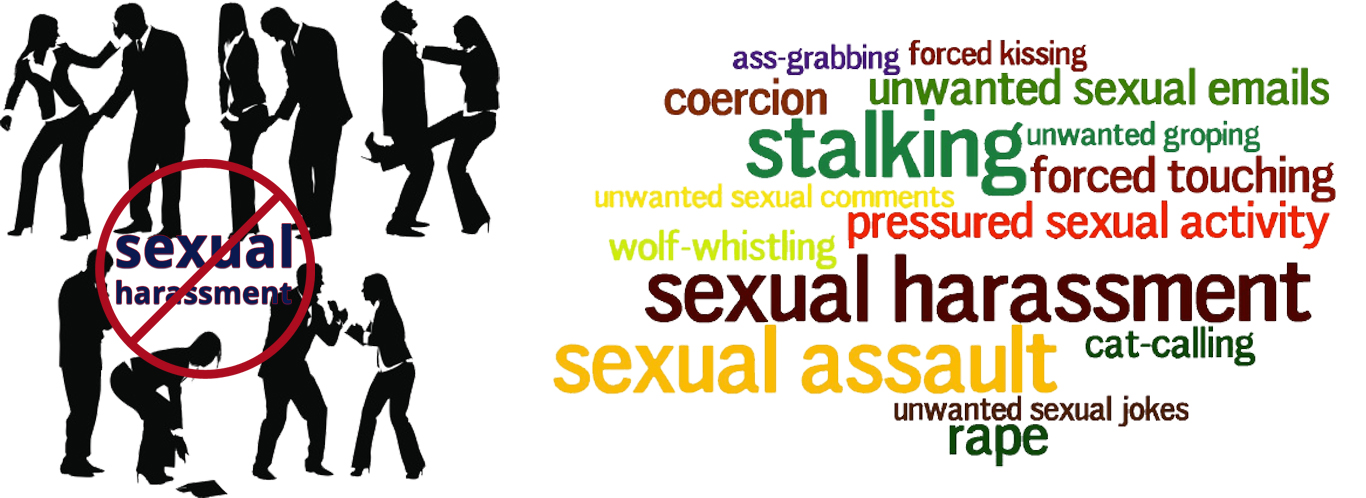Sexual harassment at Workplace
what is classed as sexual harassment?
Sexual harassment is bullying or coercion of a sexual nature, or the unwelcome or inappropriate promise of rewards in exchange for sexual favors. In most modern legal contexts, sexual harassment is illegal.It is unlawful to harass a person (an applicant or employee) because of that person's sex.Harassment can include "sexual harassment" or unwelcome sexual advances, requests for sexual favors, and other verbal or physical harassment of a sexual nature. The legal definition of sexual harassment varies by jurisdiction.
Although laws surrounding sexual harassment exist, they generally do not prohibit simple teasing, offhand comments, or minor isolated incidents — that is, they do not impose a "general civility code". In the workplace, harassment may be considered illegal when it is so frequent or severe that it creates a hostile or offensive work environment or when it results in an adverse employment decision (such as the victim being fired or demoted, or when the victim decides to quit the job). The legal and social understanding of sexual harassment, however, varies by culture.
The harasser can be the victim's supervisor, a supervisor in another area, a co-worker, or someone who is not an employee of the employer, such as a client or customer, and harassers or victims can be of any gender.
It includes a range of actions from mild transgressions to sexual abuse or sexual assault. Sexual harassment is a form of illegal employment discrimination in many countries, and is a form of abuse (sexual and psychological) and bullying. For many businesses or organizations, preventing sexual harassment, and defending employees from sexual harassment charges, have become key goals of legal decision-making.

Situations
Sexual harassment at workplace may occur in a variety of circumstances—in factories, school, academia, etc. Often, but not always, the perpetrator is in a position of power or authority over the victim (due to differences in age, or social, political, educational or employment relationships) or expecting to receive such power or authority in form of promotion. Forms of harassment relationships include:
The perpetrator can be anyone, such as a client, a co-worker, a parent or legal guardian, relative, a teacher or professor, a student, a friend, or a stranger.
The victim does not have to be the person directly harassed but can be a witness of such behavior who finds the behavior offensive and is affected by it.
The place of harassment occurrence may vary from school, university, workplace and other.
There may or may not be other witnesses or attendances.
The perpetrator may be completely unaware that his or her behavior is offensive or constitutes sexual harassment or may be completely unaware that his or her actions could against sexual harassment laws.
The incident can take place in situations in which the harassed person may not be aware of or understand what is happening.
The incident may be one time occurrence but more often it has a type of repetitiveness.
Adverse effects on the target are common in the form of stress and social withdrawal, sleep and eating difficulties, overall health impairment, etc.
The victim and perpetrator can be any gender.
The perpetrator does not have to be of the opposite sex.
The incident can result from a situation in which the perpetrator thinks they are making themselves clear, but is not understood the way they intended. The misunderstanding can either be reasonable or unreasonable. An example of unreasonable is when a woman holds a certain stereotypical view of a man such that she did not understand the man’s explicit message to stop.
With the advent of the Internet, social interactions, including sexual harassment, increasingly occur online, for example on social media.
Facts related to sexual harassment at workplace
- 79% of victims are women, 21% are men.
- 51% are harassed by a supervisor
- Business, trade, banking, and finance are the biggest industries where sexual harassment occurs
- 12% received threats of termination if they did not comply with their requests
Act for prevention of sexual harassment at workplace
- - Sexual Harassment of Women at Workplace Act(Prevention, Prohibition and Redressal),2013-The act ensures that women are protected against sexual harassment at all the workplace,be it private or public.
We will provide services are specifically customized to accomplish individual !
All the above services are specifically customized to accomplish individual client requirements.







